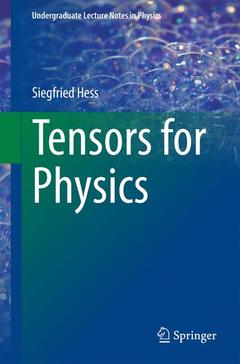Tensors for Physics, 2015 Undergraduate Lecture Notes in Physics Series
Auteur : Hess Siegfried

Siegfried Hess studied Mathematics and Physics at the University Erlangen-Nürnberg, was a graduate student in Chemical Engineering at the University of Minnesota in Minneapolis, USA and got his PhD in Physics in Erlangen in 1967. He was postdoc at the Kamerlingh Onnes Laboratory of the University Leiden, Holland and made his habilitation in Physics in Erlangen, 1970. Later, he became professor for Theoretical Physics in Erlangen and from 1984 till 2007 he held the chair for Transport Theory and Statistical Physics at the Institute for Theoretical Physics of the Technical University Berlin. As guest scientist and visiting professor he worked at the Department of Physics of the University of Toronto, Canada, at the Huygens Laboratory of the University Leiden, at the National Bureau of Standards (NBS, now NIST) in Boulder, Colorado, USA, at the Institute Laue-Langevin in Grenoble, France, at the department of Chemistry of the National Australian University in Canberra and at the Institute for Theoretical Physics (ITP, now KITP) of the University of California in Santa Barbara.
Siegfried Hess was involved in numerous national and international research projects, both as project leader and as reviewer and adviser. His scientific work is documented in over 250 publications. The list of publications features the names of over 100 co-authors, viz. of students, postdocs and colleagues, from about 20 countries and of all 5 continents. He was fond of demonstrating the advantages of the use of Cartesian Tensors in teaching the courses of Theoretical Physics and in his research dealing with equilibrium and non-equilibrium properties of anisotropic fluids and other topics of condensed matter physics.
Supports learning and teaching with extended exercises at the end of every chapter including solutions
Contains numerous examples for efficient description of anisotropies in physical phenomena
Describes how to use tensors to calculate anisotropical properties of orientational phenomena in the theoretical description, in addition to vector analysis
Presents vector analysis using Cartesian components
Contains a chapter on the physics of liquid crystals, the best model application of the tensor algebra
Includes supplementary material: sn.pub/extras
Date de parution : 05-2015
Ouvrage de 440 p.
15.5x23.5 cm
